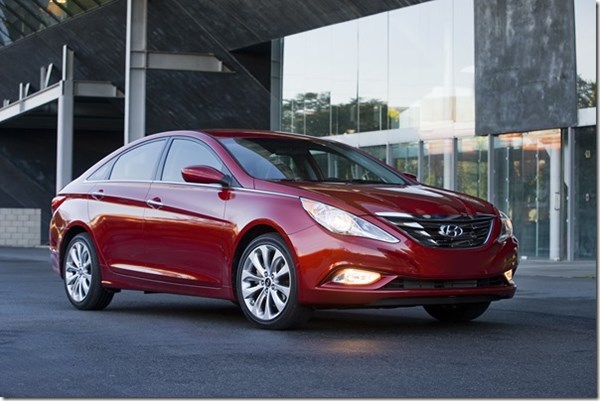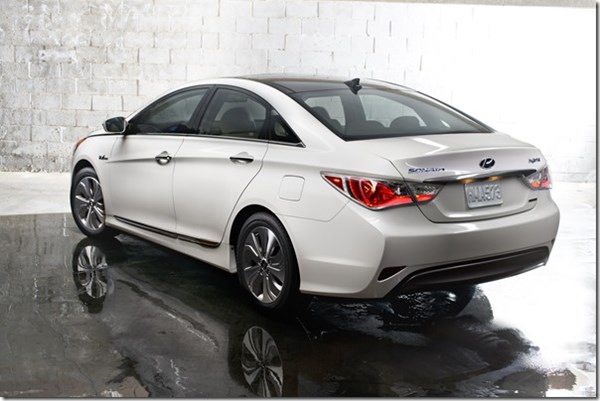2013 Hyundai Sonata Hybrid
The Hyundai Sonata Hybrid is a wonderful car for those who like the Hyundai Sonata and who would like to minimize the amount of time they spend visiting gas stations.
#hybrid #electronics #interior
The Hyundai Sonata Hybrid is a wonderful car for those who like the Hyundai Sonata and who would like to minimize the amount of time they spend visiting gas stations. It has most of the design cues of the conventional Sonata, but for some reason, perhaps to distinguish the hybrid from the non, there is a change to the front fascia, a change, I’d argue, not for the better.
Rather than having a chrome grille with a nice pattern, there is what can be generously described as a “gaping maw” that has a horizontal slab of black plastic running in that space, perhaps not unlike the mouth of an lineman with a mouth protector in place.


Maybe there is something functional to it. And if that is the case, one might wonder why it doesn’t appear to be more technical—yes, there have been hybrids out there for a number of years now, but they are still somewhat special as compared with the millions of non-hybrids on the road, so doing something more special is certainly germane.
And whoever was responsible for the tail lamps on the Sonata Hybrid certainly got that memo, because we’re talking ultramodern back there. Full marks to that person.

Hyundai calls its hybrid setup “Hybrid Blue Drive.” Blue is the new green for some reason, as other OEMs have taken that primary color to signify environmentally responsible vehicles, as well.
The Hybrid Blue Drive here has a 35-kW electric motor that draws juice from a 47-kW lithium polymer battery pack, a pack that gets its power from a 2.4-liter Atkinson cycle engine.

One of the remarkable things about the Sonata Hybrid’s powertrain is that you can be rolling along at 75 mpg and happen to notice a light in the gauge cluster that indicates the vehicle is being powered by the electric motor. What’s more likely is that should you be driving the car at a variety of speeds that are more in the realm of a daily commute you’ll see that light going on, which is a clue that you’re saving gasoline. It’s a green light. Green means you’re saving green. (Oh, alright, and being green, as well.)
You actually need to see the light because they’ve done a good job of setting things up so that going in and out of electric mode is not in the least bit clunky. This is a result of the hybrid starter generator. You don’t need to know anything about that.
Nor do you really need to know anything about the lithium-polymer battery pack (e.g., were I to say that it uses manganese-spinel chemistry, would you really know any more than you did before you read that? I think not). What you probably would want to know is that Hyundai provides a Hybrid Lifetime Battery Warranty.
That’s right: you buy the car, the battery goes bad, they replace it and recycle it for you.
For some reason there is a concern about hybrid (or full electric vehicle) batteries going bad. Let me hasten to point out that this is across the board, not just related to Hyundai or manganese-spinel chemistry. The hybrid skeptics like to point out that it will cost a boatload of money when that battery needs to be changed, so only someone foolish would buy a hybrid. Hyundai is clearly squelching that. And have those hybrid scolds ever heard of someone’s engine or transmission failing in non-hybrid cars? Sorry, folks, but even the highest-quality car is still an assembly that can break. (Why do you think that every OEM offers a powertrain warranty? It is worth adding here that Hyundai offers an industry-leading 10-year powertrain warranty.)
Another point of quibbling is whether you’re going to save enough on the gas in order to cost-justify the car. Or whether the EPA numbers have any relationship to the numbers that one is going to see displayed on a digital readout.
The Sonata Hybrid sticker numbers are 36 mpg city, 40 mpg highway, 38 mpg combined. Generally when I drive a car I figure that those numbers are at least 20% generous. Yet with the Sonata Hybrid I got a combined 36, which certainly is a nice number for a car of its size and fulsome amenities. And as the car starts at $25,650, it is a value in and of itself, whether gas goes down a dime a gallon for a week or two (and let’s face it, the rise is more predictable and consistent than the fall).
Selected specs
Engine: 2.4-liter MPI Atkinson cycle, 4-cylinder DOHC 16-valve with DCVVT
Horsepower: 159 @ 5,500 rpm
Torque: 154 lb-ft @ 4,500 rpm
Materials: Aluminum block and head
Electric motor: Interior-permanent magnet synchronous motor
Horsepower: 35 kW
Combined horsepower: 199 @ 5,500 rpm
Transmission: Six-speed electronic automatic
Wheelbase: 110.0 in.
Length: 189.8 in.
Width: 72.2 in.
Passenger volume: 103.8 cu. ft.
Cargo volume: 12.1 cu. ft.
EPA: 36/40/38 city/highway/combined mpg
RELATED CONTENT
-
Honda Re-Imagines and Re-Engineers the Ridgeline
When Honda announced the first-generation Ridgeline in 2005, it opened the press release describing the vehicle: “The Honda Ridgeline re-defines what a truck can be with its true half-ton bed payload capability, an interior similar to a full-size truck and the exterior length of a compact truck.” And all that said, people simply couldn’t get over the way there is a diagonal piece, a sail-shaped buttress, between the cab and the box.
-
Autoline After Hours: The 2020 Cadillac XT6
Cadillac currently has three non-car vehicles in its lineup, the imposing and possibly venerable Escalade, the XT5, which started its existence as the SRX and is now crushing it in the market, and the most recent, the compact XT4, which is in a sweet spot for those looking to get into the premium portion of the market.
-
2018 Ford EcoSport: Small Is the New Big
Eric Loeffler, chief program engineer for the 2018 Ford EcoSport, recalls driving home from work one day from the product development center in Brazil where work was underway on developing the vehicle that will be coming to the U.S. in 2018, having been launched in 2003 in South America and is now become available in 140 countries around the world.


.jpg;width=70;height=70;mode=crop)